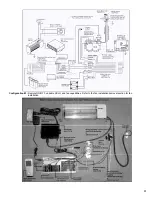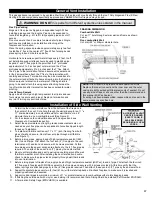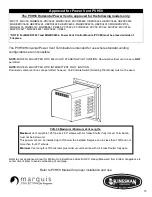
Venting Straight Up Through Roof
An Attic Insulation Shield must be installed where the vent passes from a lower living space into an attic space where the chimney is
not enclosed. It is designed to keep insulation materials away from the chimney.
When installing the Attic Insulation Shield where the chimney passes from a living space to an attic space, install the shield from below
and nail in place using 1" spiral nails.
A fire stop must be installed on the bottom side of the joists when passing through a ceiling or floor. If an attic insulation shield is to be
used, a fire stop is not required.
Using Flex Bends
Avoid cutting joists by offsetting the flex pipe.
When using 45° bends a bend support is required directly above the highest bend.
When installing a bend in a joist area a minimum of 4" clearance to combustible to the top of bend must be maintained, sides and
bottom of pipe, a 1" clearance to combustibles must be maintained. If running horizontal through an area a 1-1/2" minimum clearance to
the top of the horizontal pipe must be maintained.
Maximum vertical height of system should not exceed 43 feet.
Use roof support and rigid pipe at roof level. Flex pipe is not permitted within roof support.
When penetrating the roof a rigid galvanized pipe must be used. Attach flex pipe to the rigid pipe with high temperature sealant, secure
with four screws assuring the flex pipe and rigid pipe are secured. Attach rigid pipe to termination with sealant and screw with 4 sheet
metal screws. The Inner flex pipe must be secured with 4 screws which must penetrate both the flex pipe and inner section of
termination.
Attach 7” rigid pipe to 7” termination with sealant and screw with 4 sheet metal screws.
Vertical termination clearance is 18" [45.7cm] above the roof, measured from highest point of exit on the roof line.
Support vertical pipes to maintain minimum of one inch or greater clearances to combustibles.
Roof Flashing
Ensure that you have the proper roof flashing by checking your roof pitch using a level and two rulers, or by using a roof pitch card.
Slide a Roof Flashing suitable to your roof slope over the vent. Place the edge of the flashing plate that will be on the higher part of the
roof slope under the shingles. Both the sides and the lower edge lay on top of the shingles.
NOTE: At the top edge of the flashing plate, lift the shingles and nail the plate to the roof deck, then cement the shingles to
the plate with a suitable waterproof mastic.
Ensure that the chimney is plumb. Square up the flashing plate and nail in place to the roof deck. Use 12 nails with neoprene washers
or cover the heads with a suitable waterproof mastic. Wrap the storm collar around the vent above the flashing. Secure the ends
together loosely with nut and bolt supplied. Slide the collar down the vent until it comes in contact with the flashing. Tighten the bolt and
seal the Storm Collar to the vent with a suitable waterproof non-combustible mastic.
The flashing and storm collar should be painted to match the roof shingles. This will extend its life and improve the appearance. Clean,
prime and paint with suitable painting products.
Vertical Venting in Cold Climates
In cold climate conditions where temperatures go below -10 degrees Celsius or 14 degrees Fahrenheit, we recommend that the chase
be insulated and where the vent pipe enters into the attic space that the pipe be wrapped with an insulated Mylar sleeve. This will
increase the temperature of the vent and help the appliance to vent properly in cold weather conditions.
It is also important in vertical vented direct vent appliances that the appliance be operated daily during the winter months as this will
help stop the termination from freezing up.
We recommend using a thermostat set at room temperature to allow the unit to cycle.
For IPI models it may be necessary to set the appliance to Standing Pilot mode to maintain heat in the cavity. The purpose of this
procedure is to prevent cold air from penetrating the chimney and then onto the living space. Therefore, when the internal temperature
is slightly elevated the fireplace is able to freely exhaust its combustion and hence making it easier to startup.
-ALSO SEE DIAGRAMS ON FOLLOWING PAGE-
Attic Insulation Shield
Fire Stop
70








































